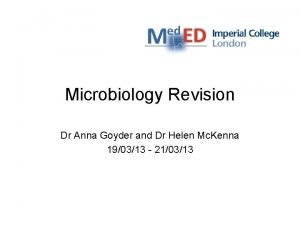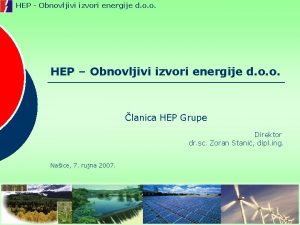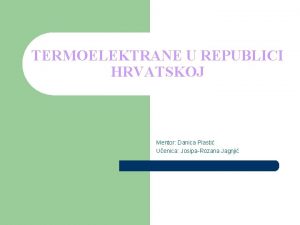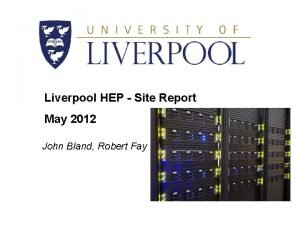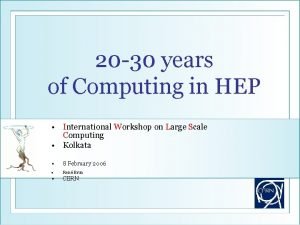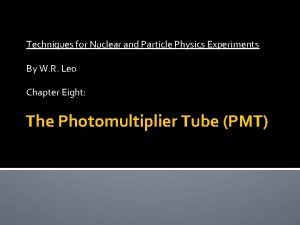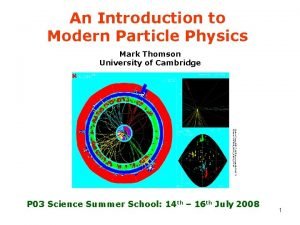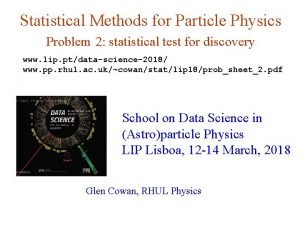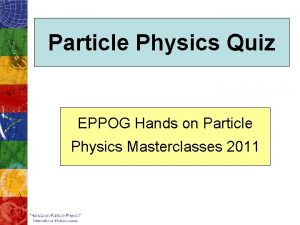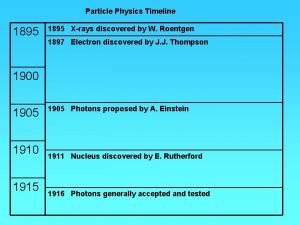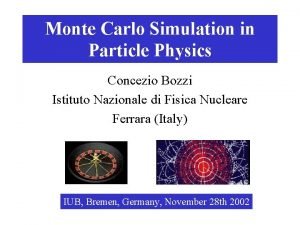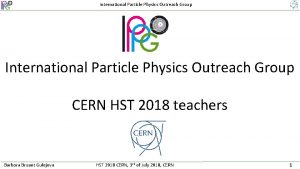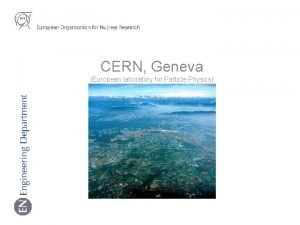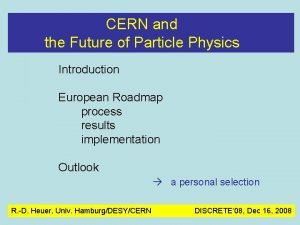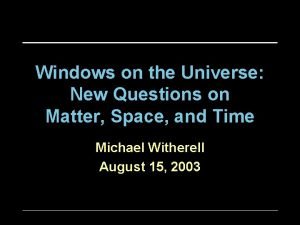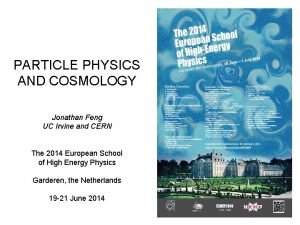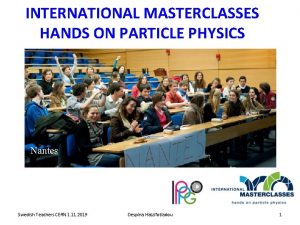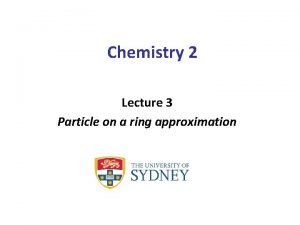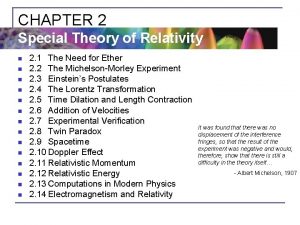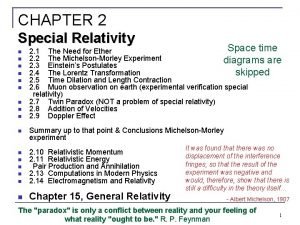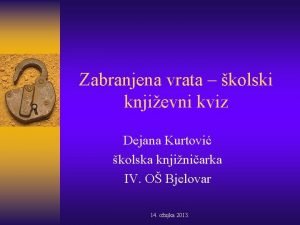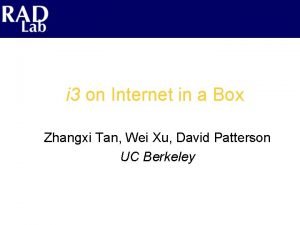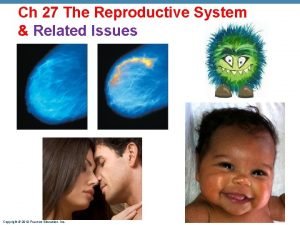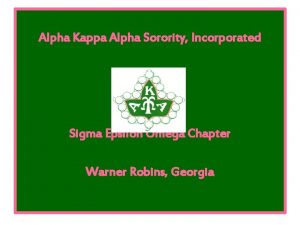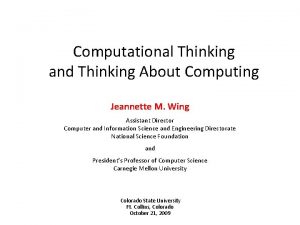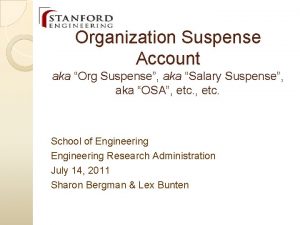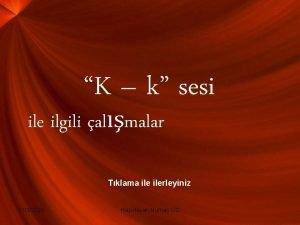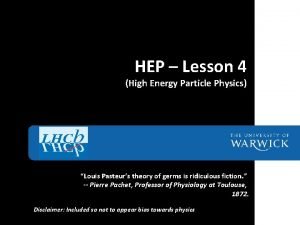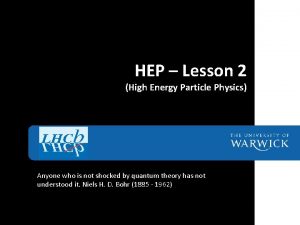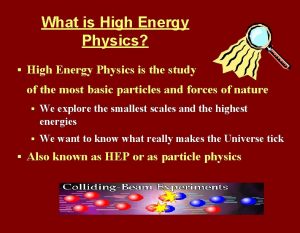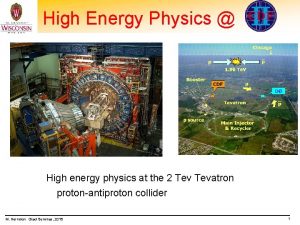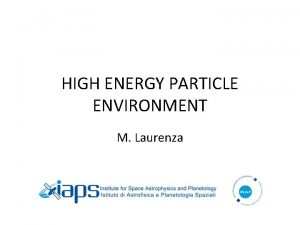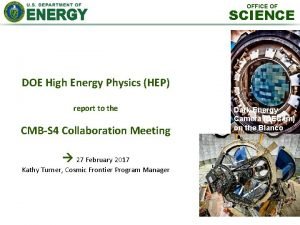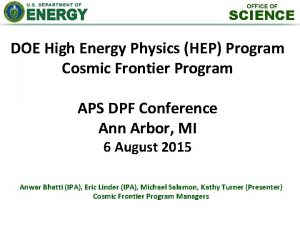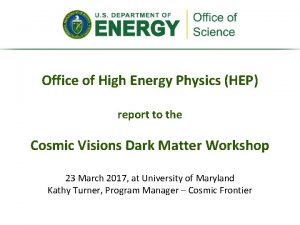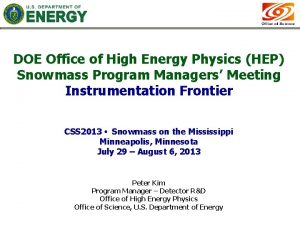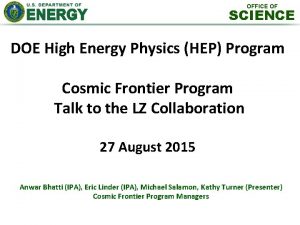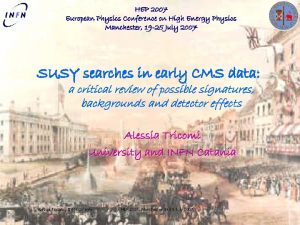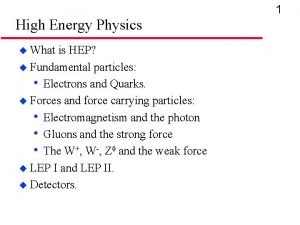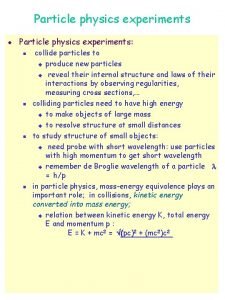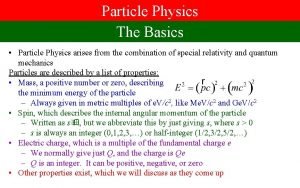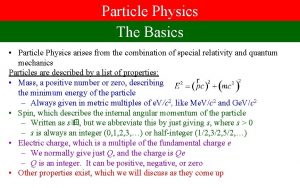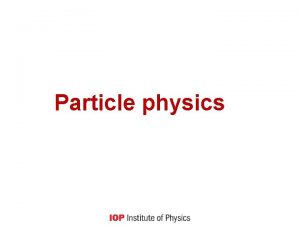High Energy Physics 3 HEP aka particle physics










































































- Slides: 74

High Energy Physics (3 HEP) aka “particle physics” Dr. Paul D. Stevenson 2009

Outline of Course • • • Relativistic kinematics. Particle detectors, beam characteristics. Classification of elementary particles. Leptons, hadrons and bosons. Symmetry and anitsymmetry. Interaction between particles. Conservation laws. The four fundamental forces – strong, weak, electromagnetic and gravitational; Composite particles: quark and gluon structure of mesons and baryons, colour charge, Pauli exclusion principle. Quantum numbers: spin, isospin, parity, strangeness, charm, bottomness, topness. Production and decay of particles. Particles and antiparticles. The evidence for all these quantities. Scattering experiments; evidence for parton structure; deep inelastic scattering off nuclei, nucleons; Limits of the Standard Model: evidence for number of particle families, CKM matrix and unitarity. The Higgs boson.

What we know about the universe This course is about the following basic building blocks: Electron, electron neutrino, up & down quarks Muon, mu neutrino, charm & strange quarks Tauon, tau neutrino, bottom & top quarks And… Photon, W & Z bosons, gluons Higgs boson (maybe) But not… The other 96% of the universe

Results from WMAP http: //map. gsfc. nasa. gov/m_mm. html We don’t know much about Dark Energy, but will touch on some Dark Matter candidates later on in the course

Units In particle physics, a somewhat curious system of units is used which are called “natural” units and set the units of velocity to be the speed of light, c, and the standard unit of action to be ħ. In other words ħ=c=1. The units of energy used are electron volts (e. V) and its multiples (ke. V, Ge. V etc). By choosing these “natural units, ” all occurrences of ħ and c are omitted from equations so that E 2=p 2 c 2+m 2 c 4 becomes E 2=p 2+m 2

Units All quantities now have the dimension of some power of energy since they can be expressed as some combination of ħ, c and energy. For example, mass, length and time can be expressed as M=E/c 2, L=ħc/E, T=ħ/E Because of this, note that if the SI dimension of a quantity are Mp. Lq. Tr then in natural units they are En=Ep-q-r. To convert expressions back to “normal” units, factors of ħ and c are inserted by dimensional arguments and then ħ = 6. 528 x 10 -22 Me. V s

Example The cross section for Thomson Scattering (photon scattering from free electrons when the photon energy is much less than me) is To turn this into practical units, we write and demand that the cross section has units of length-squared. We find a=2, b=-2 so

Collisions and Decays Most experimental particle physics is concerned with collisions and decays. Collisions: a+b->c+d Given the initial particles we can have different final states: these are called channels. We can observe many things in a given collision: the directions of c and d, their polarisation etc. We are interested also in the crosssection of the process. For each different channel we can define a partial cross-section.

Decays Decay processes are a -> b + c + d + … The main quantity of interest is the decay rate in the measured final state. This is also known as the partial width Γbcd to final state b + c + d The total width is the sum of all partial widths and is denoted Γ. It is the reciprocal of the lifetime Γ=1/τ The branching ratio of a into b + c + d is the ratio Rabc = Γbcd/Γ. In unnatural units, we have Γ=ħ/τ.

Beam Characteristics Consider a beam colliding with a target The beam consists of particles of a definite type, moving approximately in the same direction. The beam intensity Ib is the number of incident particles per unit time. The beam flux Φb is the intensity per unit normal section. The target is a piece of matter with scattering centres, which might be nuclei, nucleons, quarks or electrons depending on what we are trying to look at. Let nt be the number of scattering centres per unit volume, Nt be their total number The interaction rate Ri is the number of interactions per unit time. By definition the cross-section σi is Ri = σNtΦb = WNt. (W=rate per particle in target)




Antiparticles Assume that a particle in free space is described by a de Broglie wavefunction: Then using E=p 2/2 m, it is seen that the wavefunction obeys the Schrödinger equation: But we now know (from relativity) that E 2=p 2 c 2+m 2 c 4 So what is a suitable form for a relativistic wave equation?

Klein-Gordon Equation But for any plane wave solution, there is an equivalent one with the opposite sign of energy. The negative energy solutions are a consequence of the quadratic mass-energy relations and cannot be avoided Dirac extended the above equation to apply to spin-1/2 objects (e. g. electrons), and the results agreed impressively with experiment (e. g by predicting the correct magnetic moment).

Dirac Hole Theory The negative energy states remained, and Dirac picture the vacuum as a “sea” of negative energy electron states combining to give a total energy, momentum and spin of zero. Vacuum� state means negative energy states filled with electrons

Positrons When a “hole” is created in the negative energy sea, Dirac postulated that this corresponds to a particle with positive charge, but with mass equal to the electron, called the positron or anti-electron. γ

• Note that removing an electron with energy E=-Ep<0, momentum -p, and charge -e from the vacuum (which has E=0, p=0, Q=0) leaves the state with a positive energy and momentum and with a positive charge. • This state cannot be distinguished in any measurement from the situation in which an equivalent positive energy particle is added to the system. • Dirac postulated the existence of the positron based on this hole theory in 1928 • Not everyone took this idea seriously: – “Dirac has tried to identify holes with antielectrons … We do not believe that this explanation can be seriously considered” (Handbuch der Physik, 246 (1933)) • The positron was discovered experimentally in 1933

Anderson, Physical Review 43, 491 (1933)

Antiparticles in General • Any particle with spin-1/2 obeys the Dirac equation, and the hole theory applies. This means every spin-1/2 particle has an antiparticle. • Spin-0 particles do not obey the Dirac equation and do not feel the Pauli Exclusion Princliple on which hole-theory depends, and do not (necessarily) have antiparticles. Need to extend the list of fundamental particles:

Leptons The fundamental fermions (particles with spin-1/2) which do not feel the strong force are called leptons. They are electron: Charge -e, mass 511 ke. V, stable electron neutrino: charge 0, mass ? §, stable# muon: charge -e, mass 105 Me. V, lifetime 2 x 10 -6 s muon neutrino: charge 0, mass ? §, stable# tau: charge -e, mass 1. 78 Ge. V, lifetime 3 x 10 -13 s tau neutrino: charge 0, mass ? #, stable# § neutrino masses non-zero but small. See later. # neutrinos do not decay, but oscillate. see later, too.

Interactions The charged leptons interact via the electromagnetic interaction (like all charged particles) and the weak interaction (like all particles) The uncharged leptons (i. e. the neutrinos) interact only via the weak interaction, mediated by W and Z bosons In all interactions, it is observed that the following numbers are conserved: Le = N(e-) - N(e+) + N(ve) - N( ) Lµ = N(µ-) - N(µ+) + N(vµ)-N( ) L = N( -) - N( +) + N(v ) - N( )

Lepton processes Since neutrinos do not feel the electromagnetic interaction, in electromagnetic processes, the Le conservation rule reduces to the conservation of N(e-)-N(e+). This implies that in electromagnetic processes, electrons and positrons can only be created or annihilated in pairs. In weak interactions, other possibilities exist. For example, the following beta-decay process is allowed: n → p + e- + because the total Le number on the left (0) is equal to the number on the right (1 -1=0) Charge is also conserved, which is required in all physical processes

Disallowed processes Various processes are allowed by energy conservation, but not by some of the empirical conservations laws, e. g.

Neutrino interactions Neutrinos are very hard to detect, because they interact only via the weak interaction. This means that the scattering amplitude (determining the probability of reactions to occur) is small because of the large mass of the W and Z particles. Its existence was postulated in 1930 by Fermi to appear in ß-decay. If ß-decay had a two-body final state (Z, N) → (Z+1, N-1) + ethen the energy of the electron would be uniquely determined by However, experimentally, electrons are observed to have a range of energies. If a neutrino is also present the energy of the electron can lie in the range

Neutrino detection Though postulated in 1930, neutrinos were not detected until 1956. They can be detected in the following processes: These have a cross section of around 10 -47 m 2 which means that a neutrino would typically have to travel through many light years of matter before interaction. If the neutrino flux is large enough, however, sufficient events can be seen in much smaller (!) detectors. see article from G. L. Trigg, Landmark Experiments in 20 th Century Physics


Heavier Leptons electrons are the lightest charged particles, and as such can not decay (since charge must be conserved). Muons behave very much like electrons, except that their mass is much larger (105. 7 Me. V/c 2 compared to 0. 511 Me. V/c 2). In particular, they satisfy the Dirac equation for point-like spin-1/2 particles, and their magnetic moment is µ=(e/mµ)S indicating that there is no substructure, and the muon is an elementary particle.

Lepton Decay Muons decay with a lifetime of 2. 2 x 10 -6 s via Taus decay to many different final states. This is because there mass is sufficiently high that many different allowed combinations of particles have a lower rest-mass energy than the tau. The different decays are characterised by their branching ratio, which gives the fraction of decays to a given final state compared to all decays. For taus we have

Lepton Universality electrons are light and stable, and are stopped by a modest thickness of lead. muons are about 200 times heavier and are very penetrating. taus are much heavier still and has a lifetime many orders of magnitude below the muon. Nevertheless, all experimental data is consistent with the assumption that the interactions of the electron with its neutrino, the muon with its neutrino and the tau with its neutrino are identical, provided the mass difference is taken into account. This is know as Lepton Universality. e. g. the decay rate for a weak process is predicted to be proportional to the Q-value multiplied by the same GF 2 independent of kind of lepton: for example, In excellent agreement with experiment

Neutrino Mass The masses of particles is not predicted by the standard model. Neutrinos certainly have a very small mass (e. g. as measured by the electron energy distribution in beta decay, and had usually been considered to be zero. If the neutrino masses are not zero, neutrino mixing can occur. This happens because the weak neutrino states ( e ) need not be the same as the mass neutrino states ( 1 2 3) but linear combinations of them. For simplicity, let’s consider the mixing of two states in the following way:

Oscillations Consider an electron neutrino created at time t=0 with momentum p as After a time t it will be in a state corresponding to a probability of having changed weak eigenstate of

Detection When cosmic ray protons collide with atoms in the atmosphere, they create many pions which decay to neutrinos via One would expect then to have twice as many muon neutrinos as electron neutrinos, but the observed ratio was about 1. 3: 1 Neutrinos do oscillate.

Quarks The six quark types, or flavours, know to exist are given below: Name Symbol Mass (Ge. V) Q/e Lifetime(s) Down d ≈0. 3 -1/3 Up u ≈0. 3 2/3 Strange s ≈0. 5 -1. 3 10 -8 -10 -10 Charmed c ≈1. 5 2/3 10 -12 -10 -13 Bottom b ≈4. 5 -1/3 10 -12 -10 -13 Top t ≈180 2/3 ~10 -25

Quarks Unlike the leptons, quarks are never seen as free particles but only in the following combinations: baryons: qqq antibaryons: mesons: Collectively, these resulting particles are known as hadrons. No other combination are seen, though it is thought that other possibilities could exist (e. g. pentaquark states)

Quarks and Interactions Quarks (and hence hadrons) feel the weak interaction (because all known particles do), the electromagnetic interaction (because they are charged) and also the strong interaction, mediated by gluons. Despite the fact that they are never seen in isolation, the evidence for their existence is compelling because of: • hadron spectroscopy • deep-inelastic scattering • Jets

Spectroscopy Combining quarks in the allowed forms of baryons or mesons correctly reproduces all known hadrons, e. g. p = uud n = udd = uds + = K+ = B- = etc. Additive properties like charge are seen to agree straightforwardly with the quark model. A large part of the mass is associated with the binding energy, and is not easy to calculate. Young man, if I could remember the names of all these particles, I would have been a botanist -- Enrico Fermi

Hadron quantum numbers Various quantum numbers are associated with hadrons. Some are related to symmetry operations, and some are intrinsic to the quarks. The quark quantum numbers are the electric charge Q, and baryon number B, which are conserved in all known interactions, and the strangeness S, charm C, beauty B’ and truth T, which are conserved in strong and electromagnetic, but not in weak, interactions quark Q/e B S C B’ T d -1/3 0 0 u 2/3 1/3 0 0 s -1/3 -1 0 0 0 c 2/3 1/3 0 1 0 0 b -1/3 0 0 -1 0 t 2/3 1/3 0 0 0 1

Isospin For partly historical reasons, the internal quantum number associated with the up and down quarks works a little differently. Heisenberg thought that the similarity in mass between the neutron and the proton meant that there was some underlying symmetry which was only broken by the charge on the proton vs the lack of charge on the neutron. He called this isospin symmetry, because it behaves like an angular momentum, and thought of the nucleon as an isospin-1/2 system, with the proton being the +1/2 projection and the neutron the -1/2 projection on the third axis. Similarly for other families of particles with similar masses and other properties:

Isospin Particle B Q I I 3 (1116) 1 0 0 0 p(938) 1 1 1/2 n(940) 1 0 1/2 -1/2 K+(494) 0 1 1/2 K 0(498) 0 0 1/2 -1/2 +(140) 0 1 1 1 0(135) 0 0 1 0 -(140) 0 -1 1 -1

quark isospin u & d quarks are an isodoublet, both with I=1/2, but d has I 3=Iz=1/2, u has I 3=Iz=+1/2 the equivalent antiquarks are also an isodoublet with I=1/2, but with opposite third-components. Another quantum number is often used, which is derived from the known ones, called hypercharge: Y=B+S+C+B’+T and then for a hadron, I 3=Q-Y/2

Example: How new particles can be identified by the quantum numbers and conservation laws. When a K- is fired at a proton target, they can interact (with a cross section appropriate to the strong interaction to give an - and a new particle +, which decays with weak interaction lifetimes to + + + n, or + 0 + p. Applying conservation of B, S, C, B’, T to the K-+p - + + reaction, and using the known values for K- (B=0, S=-1, C=B’=T=0), p ( B=1, S=0, C=B’=T=0) and - (B=0, S=C=B’=T=0) tells us that for the +, B=1, S=-1, C=B’=T=0. From the relationship between hypercharge and isospin, we also infer I 3=1. It must therefore be part of an isotriplet, and partners of similar mass but different isospin should exist, as indeed they do. We can infer the quark structure from the quantum numbers as uus (n. b components of vectors are always additive)

Space-Time Symmetries As well as the quantum numbers associated directly with intrinsic quark properties, particles (including the leptons) have quantum numbers associated with spatial properties. These are Spin, J, Parity, P, and Charge Conjugation, C. SPIN We use the word spin to characterise the intrinsic angular momentum of a particle whether or not it is composite. If the particle is elementary, the total spin J is equal to the intrinsic spin S, e. g. 1/2 for any of the fundamental fermions (quarks & leptons)

Meson Angular Momentum Mesons are made a quark and an antiquark which have intrinsic spin of their own, and can have orbital angular momentum about their centre of mass If we first consider the case that there is no orbital angular momentum (this is the case for the lowest masss mesons) then we just have J=S and S is made by coupling together two single spins of 1/21. When coupling an angular momentum I 1 to another I 2 the allowed values of the result I are I = |I 1 -I 2|, |I 1 -I 2|+1, …, I 1+I 2 -1, I 1+I 2 Coupling 1/2 with 1/2 gives only 0 or 1 as possibilities for S and hence for J when L=0. 1 we are not including units of c or hbar. Angular momentum has units of hbar

Meson Angular Momentum If the quark and antiquark in the meson have a relative angular momentum (which is quantized in integer units of hbar) L=1, 2, 3, … then this L couples with the coupled intrinsic spin S according to the normal rules of AM coupling, I. e. the total spin J can lie anywhere (in integer steps) between |L-S| and L+S. We label the mesons in spectroscopic notation: 2 S+1 L J where L is written as the usual identifying letter: S=0, P=1, D=2, F=3, G=4 etc. . and S and J are given as numbers. So a pion, which has L=S=0 has an angular momentum configuration 1 S 0. For a given quark-antiquark pair, there are many allowed angular momentum configurations, which are identified as different particles. For example there is a state made of u (like a +) but with J=1, which is labelled as +. It can be thought of as an excited state of +, but since it has different quantum numbers, it is also thought of as a particle in its own right.

Baryon Spin In the case of baryons, the three spins of 1/2 can couple to either 3/2 or 1/2 which then couples to the orbital angular momentum, which can be any integer value. q 1 L 3 q 3 L=L 12+L 3 L 12 q 2 what are the allowed baryon states for L=0, L=1?

Parity The parity transformation is xi xi’=-xi, i. e. the position vector of every particle is reflected in the origin. If we define a parity operator P as P (x, t) = Pa (-x, t) where Pa is a phase factor. Since acting with the parity operator twice must give us back the original state, we have P 2 (x, t) =Pa 2 (x, t) and so Pa= 1

Intrinsic Parity Consider an eigenfunction of momentum then so when a particle is at rest (p=0), it is an exact eigenstate of the parity operator with eigenvalue Pa. For this reason, Pa is called the intrinsic parity of particle a, or more commonly just the parity of particle a. If a Hamiltonian is invariant under the parity transformation then [H, P]=0 and in a reaction governed by the Hamiltonian, the initial and final parities must be the same, and parity is conserved. This is true in the strong and electromagnetic interactions, but not the weak interaction.

Angular Momentum & Parity orbital angular momentum wavefunction are written in spatial coordinates as spherical harmonics in the angular part. These feature in the usual separable solutions to central-field potential in quantum mechanics: (r, , ) = R(r)Ylm( , ) The first few spherical harmonics are Y 00 = 1/sqrt(4 ) Y 10 = sqrt(3/4 ) cos Y 1 1 = - sqrt(3/8 )sin exp( i )

Spherical Harmonics Using x=rsin cos , y=rsin , z=rcos the parity transformation in polar coordinates become r r’ = r ’ = - ’ = + from which it can be shown that Ylm( , ) Ylm( - , + ) =(-1)l Ylm( , ) and (r, , ) is an eigenstate of parity with eigenvalue Pa(-1)l (where Pa is the intrinsic parity ignoring angular momentum)

Fermion Parity From Dirac’s equation one can obtain the following for any fundamental fermion and its antiparticle Parity is not conserved in the weak interaction. In the strong interaction quarks and antiquarks are always produced in pairs. Likewise the leptons and their anitleptons. One can indeed confirm the above relation experimentally but not determine the parity of the individual fermions. By convention the particles (quarks, electron etc. ) are assigned P=+1 and the antiparticles (antiquarks, positron etc. ) are then P=-1. The parity of the photon can be derived from electromagnetic theory. It is P =-1

Charge Conjugation Charge conjugation is an operation which replaces all particles by their antiparticles in the same state (so that positions, momenta etc are unchanged). Like Parity, Charge Conjugation is a good symmetry of the strong and electromagnetic interaction, but not the weak interaction. The Charge Conjugation quantum number of a particle is conserved in these interactions. It can take on the values ± 1. Its conservation can be used to understand why some reaction will work but not others, and help identify particles.

0 decay for a quark antiquark pair with given values of S, J, and L, the quark model predicts It is observed that the dominant decay mode of the 0 is 0 . Then So the final state has C=1, so too must the initial state, in agreement with the quark model prediction (since a 0, in the lightest multiplet of mesons, has L=S=0). From electromagnetism, it can be deduced that C =-1. One does not see 0 because of C-conservation in the electromagnetic interaction. Indeed, searches for this decay mode are made to look for potential C-parity breaking.

Colo(u)r The quark model is successful, but why are there no states of the form qq? Why is it always 3 quarks, 3 antiquarks or a quarkantiquark pair? Also: according to quantum mechanics, the wavefunctions for composite particles made of identical spin-1/2 quarks must be antisymmetric under interchange of any two of the quarks. But the observed properties of some particles clearly contradict this. e. g. the Ω- is observed to have strangeness S=-3 and spin J=3/2, L=0, indicating that it is made up of three identical strange quarks with their spins all pointing in the same direction, and in the same physical state. This wavefunciton is symmetric, and violates the Pauli principle.

Colo(u)r Another degree of freedom is at work. It is a property that quarks have but leptons do not, called color. It is in some sense analogous to electric charge, in that it has an associated color charge which is what the strong interaction acts on, like the electromagnetic interaction acts on charged things. There are three kinds of color state for quarks, called red, green, and blue (which do not have anything to do with real colours). Antiquarks can be antired, antigreen or antiblue. This solves the antisymmetry problem. In the Ω- the three quarks, labelled 1, 2 and 3 exist in a linear combination of different colour combinations which is antisymmetric with respect to the interchange of any two labels.

Color confinement It was hypothesised that hadrons could only exist in colorless states (either color-anticolor or rgb), which “explained” why only (anti-)baryons and mesons are seen. Quarks are colored and have non-zero color charge and are hence confined to hadrons. There is direct experimental evidence for color charge, coming from electron-positron annihilation (M&S 7. 2) Consider reactions of the type e+ + e- hadrons at rather high energies (15 -40 Ge. V) in a colliding beam experiment

Jets The primary mechanism of the reaction is that the electron and positron annihilate to a photon which then creates a (colourless) quark-antiquark pair. Because the quarks are generated with so much momentum, and they are created moving away from each other, they soon fragment into two jets of hadrons. They cannot keep travelling as isolated quarks because of color confinement. The total summed momentum for each jet lets one reconstruct the trajectory of each quark. This can be compared with the branch of e+ + e - + + -

Jet Distributions From QED the differential cross-section for this process is wellknown to generate a quark-antiquark pair in this way (via the electromagnetic interaction), the cross section is just reduced slightly by the lower charges on the quarks compared to muons, but multiplied by a factor NC which is the number of different colours available for a quark of a given flavour. So the differential cross section for generation of a quark anti-quark of flavour a will be

colour counting If you perform this experiment, and measure these cross sections as a function of energy (and integrate over angle) you should see the ratio Increase as more quark channels open up. For example, when u, d, s, c, b quarks are available, the ratio should be 11 NC/9


The Strong Interaction & QCD stands for Quantum Chromo. Dynamics and is theory which governs the strong interaction. The strong interaction acts by the exchange of gluons, which interact with objects with color charge, so in particular with quarks. Gluons are spin-1 bosons, which also have color charge, so gluons interact with themselves. This gives rise to curiosities such as glueball states which are made entirely of gluons. no such state has been conclusively observed, though there are some candidates. In some circumstances the rather complicated QCD interactions can be approximated by a static potential between quarks (esp. if the quarks are heavy)

quark potential At short distances, the interaction between a heavy quark and its antiquark is dominated by single gluon exchange. This gives rise to a coulomb-like potential V(r)=-(4/3) ( S/r) for r<0. 1 fm because of color confinement, the strength of the interaction actually increases quite rapidly as you increase the distance between the quark and antiquark. This means a lot of energy is stored in the field which can turn into quark-antiquark pairs to stop the colored quarks from getting too far apart. Emprically the potential looks like: V(r) r


asymptotic freedom The strong coupling constant S is not actually constant, but varies as a function of momentum transfer At high values of momentum transfer (short distances) the coupling constant gets weaker. This means that when quarks are close to each other, the become more “free” from the strong force, but feel it very strongly when they try to separate.

Strong interaction summary The strong interaction acts between object with color. These are the quarks and gluons. The force is mediated by the exchange of gluons. Conserved quantities in the strong interaction: Baryon number (B), quark flavour numbers: (S, C, T, B), parity (P), charge conjugation (C) Also conserved (because all interactions conserve them): charge, angular momentum, energy. Colored objects are never observed in isolation, but only combined into colorless particles

Weak Interaction with Hadrons • There are two basic weak interaction vertices for interactions between W± and leptons: • Which give rise to 8 basic reactions when pulled around in all possible time-orderings

Lepton-Quark Symmetry The basis of weak interactions with hadrons depends on how the W± bosons are absorbed or emitted by quarks. For simplicity, we restrict discussion to the first two families of quarks: and The two main ideas in the weak interaction of quarks are leptonquark symmetry and quark mixing. They describe to a good accuracy the observed amplitudes of weak interaction events with W± bosons, and can deduce the interaction of quarks with the Z 0 (see section 9. 1. 1 in Martin & Shaw for that).

Lepton-Quark Symmetry Lepton-Quark symmetry asserts that the first two generations of quarks, as on the previous slide, and the first two generations of leptons: & have identical weak interactions. i. e. one obtains the basic vertices for weak interaction with quarks by the replacements: leaving the coupling constants unchanged

Neutron decay gw Wd d u gud u and gud = gw = gcs This idea works well in describing events such as neutron decay, and pion decay: However it does not allow observed decays such as (why? )

The Cabibbo Hypothesis To explain events such as K- decay, the idea of quark mixing was introduced. According to this idea, the d and s quarks take part in the weak interaction via the linear combinations d’ = d cos C + s sin C And s’ = -d sin C + s cos C where C is the Cabibbo mixing angle. This means that lepton-quark symmetry is assumed to apply to the doublets and

Cabibbo angle Now the previously allowed ‘ud. W’ vertex is suppressed by a factor cos C while the previously forbidden us. W vertex is now allowed with a coupling g. Wsin C and the couplings are now: gud = gcs = gwcos C gus = -gcd = gwsin C This set of couplings successfully accounts for the interaction of quarks with the W± - the so-called charged-current interactions (since the W± is the only charged force-carrying particle). The success is demonstrated partly by the fact that the only free parameter - the Cabibbo angle - in this description can be measured in different ways, and the values agree with each other

Measuring the Cabibbo Angle From the relative decay rates of determine the Cabibbo angle: to one can Of course, one must also take into account the difference in the d and s quark masses since this will have an effect on the rates. When this is done, the value is giving C=12. 7± 0. 1 degrees

Measuring the Cabibbo Angle Comparing neutron and muon decay depends on the ratio g 2 ud/g 2 w = cos C, which gives a value in agreement with that from K- / pidecay. Values of the Cabibbo angle should agree when obtained from the gcs coupling and the most accurate value for C coming from gcs is C = 12± 1 degrees, which is compatible with the value from measuring gud. Because of the value of the mixing angle, the couplings which were not allowed in the simple unmixed scheme are still heavily suppressed compared to the allowed couplings. The decay rates for cabibbosuppressed decays, which depend on the square of the couplings are suppressed by tan 2 C ≈ 1/20 compared to cabibbo-allowed decays. An example of this is that decays of particles with charmed quarks almost always have an s quark in the final state.

Third Generation The idea of quark mixing can be extended to the third generation with a mixing matrix and apply lepton-quark symmetry to the doublets , & To a reasonable approximation Vtb=1 and the other elements in the third row and column are approximately zero
 Abcdl gram positive rods
Abcdl gram positive rods Hep verlag elehrmittel anleitung
Hep verlag elehrmittel anleitung Hep b series for adults
Hep b series for adults Hep b mode of transmission
Hep b mode of transmission Hep c results interpretation
Hep c results interpretation Hcv symptoms female
Hcv symptoms female Hep forum
Hep forum Immunological tolerance
Immunological tolerance Hep obnovljivi izvori energije
Hep obnovljivi izvori energije Hep b vaccines
Hep b vaccines Hep b vaccines
Hep b vaccines Hepatitis c
Hepatitis c Termoelektrana plomin
Termoelektrana plomin Liverpool hep c
Liverpool hep c Hep international
Hep international Pmt particle physics
Pmt particle physics Mark thomson modern particle physics
Mark thomson modern particle physics Particle physics
Particle physics Particle physics practice quiz
Particle physics practice quiz Particle physics timeline
Particle physics timeline Concezio bozzi
Concezio bozzi Cern particle physics
Cern particle physics European laboratory for particle physics
European laboratory for particle physics Cern particle physics
Cern particle physics Particle physics
Particle physics Form factor particle physics
Form factor particle physics International masterclasses hands on particle physics
International masterclasses hands on particle physics Particle on a ring energy level diagram
Particle on a ring energy level diagram Kinetic energy of a relativistic particle
Kinetic energy of a relativistic particle Kinetic energy of a relativistic particle
Kinetic energy of a relativistic particle Schrodinger equation particle in a box
Schrodinger equation particle in a box Energy energy transfer and general energy analysis
Energy energy transfer and general energy analysis Energy energy transfer and general energy analysis
Energy energy transfer and general energy analysis Zabranjena vrata kviz
Zabranjena vrata kviz Shakespeare's aka the bard of
Shakespeare's aka the bard of Pyramid passion
Pyramid passion Aka catholic
Aka catholic Geneva metrics
Geneva metrics How to write a letter of interest for aka
How to write a letter of interest for aka I3on
I3on Http/ //aka.ms/remoteconnect
Http/ //aka.ms/remoteconnect Msm 365
Msm 365 Httpsaka
Httpsaka Aka captions
Aka captions Aka sustentacular cells
Aka sustentacular cells Beta epsilon omega
Beta epsilon omega Phi pi omega chapter of aka
Phi pi omega chapter of aka åka skidor tjeckien
åka skidor tjeckien Road katy
Road katy 178. aka elephant mask
178. aka elephant mask Aka bot
Aka bot Computational thinking
Computational thinking Https://slidetodoc.com/6-4-b-the-piano-method-aka-sticks/
Https://slidetodoc.com/6-4-b-the-piano-method-aka-sticks/ Kto vysoko lieta nízko padá vyznam
Kto vysoko lieta nízko padá vyznam Aka salary
Aka salary Aka.mf/sspr
Aka.mf/sspr Nurhan uz n sesi
Nurhan uz n sesi Doors of st. michael, hildesheim aka. “bernward doors”
Doors of st. michael, hildesheim aka. “bernward doors” Btk aka
Btk aka Aka.ms/hci-demo
Aka.ms/hci-demo Invitation alpha kappa alpha mip timeline
Invitation alpha kappa alpha mip timeline Pi eta omega
Pi eta omega Visit aka.ms/officetips
Visit aka.ms/officetips Verklegt ökupróf villur
Verklegt ökupróf villur Spanish grimes aka ella
Spanish grimes aka ella Aka.mf/sspr
Aka.mf/sspr Aka.ms
Aka.ms Aka.ms
Aka.ms Aka.ms.ad recovery key
Aka.ms.ad recovery key Aka.ms/mca マイクロソフト
Aka.ms/mca マイクロソフト Joblog aka
Joblog aka Aka hashing
Aka hashing Absoluteshakespeare
Absoluteshakespeare Aka.ms.ringring
Aka.ms.ringring Aka.ms/officereleasenotes
Aka.ms/officereleasenotes
